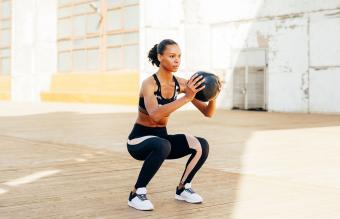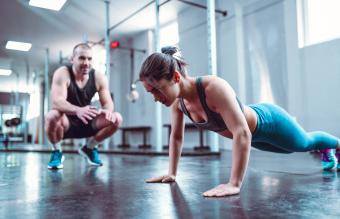
Knee pain or weakness is quite common, and many people are apprehensive about exercising this joint for fear of further injury. Strengthening the muscles around the knee can help alleviate pain and weakness. Those who have not yet experienced knee pain should add intentional exercises to keep their knees strong and avoid injury. Speak with your physician or physical therapist before exercising to ensure the movements are appropriate for you.
How to Strengthen Knees
Strong knees can help provide a good basis for a strong body that can engage in a variety of movements without pain. Cardio and strength work will both benefit from strong, stable knees. Weak knees are often the result of weak surrounding muscles, such as the quads, calves, and glutes; strengthen these muscles and your knees will benefit. Do these moves for three sets of 8-10 reps, around three times a week or during your lower body strength workouts.
Heel Raises
Heel raises help strengthen your calf muscles, which will benefit your knees greatly. They're also simple to do - more experienced exercisers can do these moves weighted with the help of a barbell or hand weights.
- Stand tall with feet side by side. Focus on keeping your spine in a neutral position and relax your shoulders.
- Slowly raise your heels off the ground for three counts, moving toward a "tip toes" position. Keep your knees soft (not locked, and not significantly bent) and focus on raising straight up without allowing your heels to go out to the side.
- Hold at the top for one count.
- Lower slowly for three counts. It's important to not just drop down, but to instead control the decline.

Squats
Some people avoid squats because they've heard they can hurt knees. While this is true if form is incorrect, squats done correctly can help strengthen the knees. Beginners can lower into a chair for stability and advanced exercisers can add hand weights or a barbell for a challenge.
- Standing with feet shoulder-width apart, lower yourself into a squat.
- Focus on allowing your legs to do the work of lowering you - your upper body should stay upright.
- Intentionally set your weight into your heels - this protects your knees.
- The decline should take three counts with a one-count squeeze of the glutes at the bottom.
- Continue squeezing and return to standing for three counts.

Deadlifts
Deadlifts strengthen the hamstrings, which helps strengthen the knees and make them more stable. Do this move with a barbell or hand weights in hand - beginners can start with small weights.
- With an overhand grip on the weights or barbell, straighten your back and hinge at the hips. Keep your knees soft.
- Keep your gaze on the floor in front of you (looking up can strain your neck).
- Lower your upper body, aiming to reach mid-shin level with the weights (if your flexibility doesn't allow this, just take the weights to thigh level).
- Raise your upper body back up.
Glute Bridges
This exercise strengthens the glutes and hamstrings, which will in turn help your knees function better and become stronger. Advanced exercisers can try this move with one leg extended. Yoga enthusiasts will recognize this exercise as similar to Setu Bandha Sarvangasana.
- Lie on your back with knees bent and feet on the ground.
- Pushing through the heels (it's OK for your toes to come off the ground and point upward if that feels more comfortable for you), squeeze your glutes and lift your hips up for a count of three.
- Pause at the top of the movement for one count. You don't want to go up so high as to only have your shoulders on the ground for your upper body as this takes the work out of the glutes.
- Return your hips to the ground slowly for a count of three, continuing to squeeze.

Alleviate Knee Pain
A mistake many people make is they stop exercising altogether after an injury or strain, only to find their knee pain gets worse from inactivity and from additional weight gained from inactivity. Consult with your medical provider to get clearance for exercise, especially if you were recently injured or had knee surgery.
Side Step
This exercise utilizes resistance bands to help strengthen the abductor muscles and glutes, which will all benefit the knees.
- Place the resistance band just above both of your ankles.
- Keeping your knees soft and your back straight, step laterally to one side. The step should be wide enough to where your feel resistance from the band.
- You can choose to either alternate your lateral steps (left-right-left-right) or do a number of steps in one direction followed by an equal number of steps in the other direction.
Walking
Walking can be quite beneficial for people with knee pain, and is certainly preferable to high-impact activities like jogging or running. Here are some tips for walking to alleviate knee pain:
- Don't carry anything extra when you walk.
- Wear quality shoes designed for walking.
- Discuss with your doctor whether a knee brace might benefit you on your walks.
- Choose flat terrain.

Yoga
Yoga helps with balance. People with knee pain sometimes find their balance interrupted as they move to avoid using their knees. Here are some tips for your yoga practice with knee pain:
- If you're taking a class, inform the instructor beforehand of your knee pain. A good, credible instructor will provide you with modifications for inappropriate poses.
- Don't use a grippy yoga mat combined with grippy yoga socks (socks which are meant to grip to the ground or mat) as this combination may further strain the muscles near your knees.
- If a movement or pose hurts, stop immediately. Don't try to power through knee pain.
Stationary Bike
A stationary bike is a fairly safe bet for cardio exercise, even with knee pain. This low-impact exercise works the lower body without putting pressure on the knees. Here are some tips for stationary bike riding:
- A recumbent bike may be more comfortable, yet delivers the same benefits as an upright stationary bike.
- Do add enough resistance to where the pedals don't spin freely, yet you don't have to push so hard as to hurt your knees.
- If you find the stationary bike to be boring, accompany your ride with a good book or watch TV or videos while you pedal.
Injury and Arthritis Considerations
Those with injuries, osteoporosis, or diagnosed arthritis should speak with their physician or physical therapist before participating in knee exercises. People with arthritis should take great care to warm up their knee joint with dynamic movements before engaging in any exercise. It's important for anyone to warm up before exercising, but for those with arthritis it's pivotal. Arthritis does not typically prohibit movement - as the right exercises can help alleviate pain - yet special considerations must be made in order to avoid further damage or pain. Speak with your medical professional about knee exercises appropriate to your specific condition.
Keep Moving
Don't allow knee pain (or the fear of knee pain) to stop you from being active. With so many ways to keep moving despite knee issues, there's no reason to fall into a pattern of inactivity.







